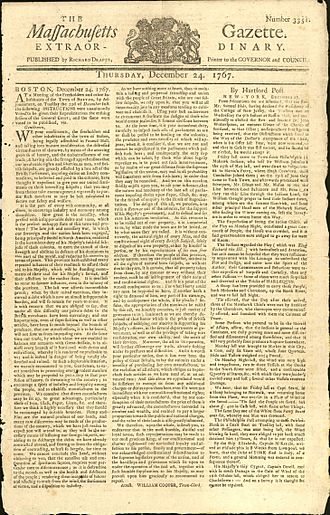The Massachusetts Gazette facts for kids
The Massachusetts Gazette was an important newspaper in America long ago, before the United States became its own country. It was started by Richard Draper. He was a printer for the British governor and his helpers in the area called the Province of Massachusetts Bay.
As the American Revolution got closer, the British government asked this newspaper to support their ideas. It was one of the few newspapers that supported the British side, known as Loyalist newspapers, during the years before the war.
Contents
The Newspaper's Story
How It Started
Richard Draper's father, John Draper, used to run a newspaper called The Boston News-Letter. He did this for 30 years. When his father passed away in November 1762, Richard took over the newspaper.
This newspaper was very loyal to the British government. As the arguments grew between Great Britain and the American colonies, Richard supported the British King. He was a Loyalist.
Richard made the newspaper's name longer, calling it The Boston Weekly News Letter and New England' Chronicle. A year later, he changed it again to The Massachusetts Gazette; and Boston News Letter. He even put the King's symbol at the top of the paper.
Joining Forces
In 1768, Richard's newspaper joined with another one called The Boston Post-Boy. Richard's Post-Boy newspaper was also very supportive of the British side, like a Tory newspaper. It almost always followed the British government's ideas.
Richard had a special job printing for Governor Bernard and his team. He used the words Massachusetts Gazette as part of his newspaper's name.
It was a bit strange for these two newspapers to join together, and it didn't last very long. Even though they were both called The Massachusetts Gazette, they still came out separately. The Post-Boy was printed on Mondays, and The News-Letter came out on Thursdays. People even called them the "Siamese Twins" of journalism. This special arrangement lasted from May 23, 1768, until September 25, 1769. After they separated, Draper only kept The News-Letter going.
Newspaper News
William Goddard shared the news about The Massachusetts Gazette starting up in his own newspaper, the Pennsylvania Chronicle. This was in the issue from February 12, 1770.
Richard Draper was often sick and had a weak body. Soon after his father died, he brought in Samuel Draper as a quiet business partner. Samuel was connected with Zechariah Fowle. They started a company called Richard. & Samuel. Draper.
The top of the Gazette newspaper said, "Published by Richard Draper, Printer to the Governor and Council, and by Samuel Draper, at the Printing Office in Newbury Street." Draper hired many writers who supported the British. However, there were more newspapers and writers who supported American independence.
Standing Up for the British
The government in Massachusetts tried hard to fight against the ideas in newspapers like The Boston Gazette. This paper had writers like Samuel Adams and the Quincys, who wanted independence. Another paper, The Spy, also had very brave writers.
So, the British authorities mostly used The Massachusetts Gazette and Weekly News-Letter to share their own views. All the writers who supported the British, like Andrew Oliver, William Brattle, Daniel Leonard, and Jonathan Sewall, wrote in this paper. They aimed their ideas at the "Whigs," who were the people who wanted independence.
The Stamp Act News
In July, news arrived in Boston about a large shipment of "stamped paper" coming to the colonies. This news was printed for the first time on August 5 in the Massachusetts Gazette & News-Letter. The newspaper also listed the people chosen to give out these stamps in different colonies. Andrew Oliver was named for Massachusetts.
At this time, many newspapers in the colonies stopped printing. They did not want to pay what they thought was an unfair tax on paper. A ship full of stamped paper arrived in Boston harbor in September.
Later Years
Richard Draper passed away on June 6, 1774. After his death, his wife and his business partner, John Boyle, took over running the newspaper.


